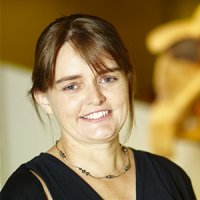Danielle Clode

Danielle Clode is an author and associate professor in creative writing at Flinders University whose first book, Continents of Curiosities, was inspired by the natural history collections of Museums Victoria. Her book Voyages to the South Seas won the Victorian Premier’s Award for Non-fiction in 2007. In 2014 she was the ABR Dahl Trust Fellow and her article ‘Seeing the Wood for the Trees’ appeared in the November 2014 issue of ABR. Her latest book is Koala: A life in trees (2022).
There are few places more restful than a riverbank on a fine day, few sights more enticing than a disappearing river bend, few places more intriguing to follow than the tumbled rocks of a creek line. Following the water, to its source or destination, seems hard-wired into our psyche.
Simon Cleary’s latest book, Everything Is Water, takes this fascination to an extreme. Rivers are easy to take f ... (read more)
What child has not been fascinated to watch the miraculous metamorphosis of a hungry caterpillar to pupae and then butterfly in a glass jar on the table? This transformation is such an everyday part of our ecological awareness as to be almost child’s play. What was once the cutting-edge technology of scientific observation – the transparent glass isolation chamber, the magnifying lens, and the ... (read more)
Megalodon, the famed prehistoric shark, is the stuff of legends. Their huge teeth – as big as the palm of a hand – fuel unquenchable rumours of their continued survival, a plethora of implausible YouTube videos, and the devoted fascination of a legion of children.
Megalodon presents as a formidable prehistoric predator of epic proportions. But just how big was it? Like the fish that got away, ... (read more)
Danielle Clode reviews 'Goldfish in the Parlour: The Victorian craze for marine life' by John Simons
The image of a solitary goldfish aimlessly circling in a glass bowl recurs in cartoons and children’s books, a metaphor for a crowded and over-scrutinised life. John Simons’s account of the mid-nineteenth-century aquarium craze reveals the rather horrifying historical reality of this mostly symbolic image. At the height of the craze for aquariums, not only were resilient goldfish kept in bowls ... (read more)
Herbariums are strange places. Part archive, part library, part museum collection, they hover in a space of plant, paper, print, and preservative. Time and space are pressed between pages representing far more than their often unprepossessing appearance suggests – complex interwoven stories of evolution, ecology, and scientific history. The herbarium is a compactus of shared and public scientifi ... (read more)
The Australian Museum is starting to develop something of a literary landscape of its own. This is not so much through official publications such as Ronald Strahan’s Rare and Curious Specimens (1979) or the flagship magazine in its various incarnations from Australian Natural History to Explore. Rather, it is through more creative or expansive stories of the weird, wonderful, and personable, fro ... (read more)
The great age of sail – of European exploration and colonisation – is typically depicted as trenchantly masculine, with the only ‘women’ being unpredictable ships and the sea itself. Women have traditionally been considered bad luck, distracting, or not tough enough for life at sea. Nonetheless, historical research is increasingly revealing that many women played active roles at sea, as co ... (read more)
Danielle Clode reviews 'A Letter to Layla: Travels to our deep past and near future' by Ramona Koval
A Letter to Layla is very much a book of our times. Its impetus lies in our rapidly changing climate, and it concludes with the unexpected impact of Covid-19. In between, the book explores both our distant past and our future.
Well known for her past career as an ABC broadcaster, Ramona Koval turns her talent for in-depth interviews and her training in science into an engaging and illuminating bo ... (read more)
As generations of Australian tourists have found, the kangaroo is a far more recognisable symbol of nationality than our generic colonial flag. Both emblematic and problematic, this group of animals has long occupied a significant and ambiguous space in the Australian psyche. Small wonder, then, that Ken Gelder and Rachael Weaver have found such rich material through which to explore our colonial ... (read more)
